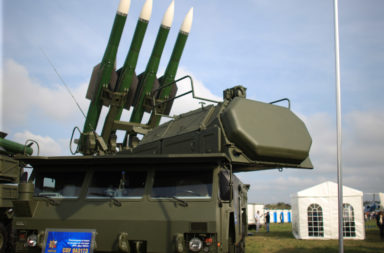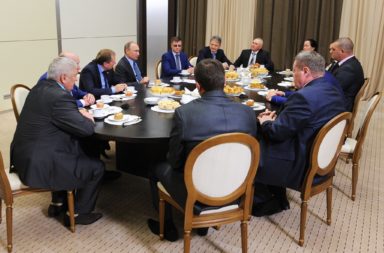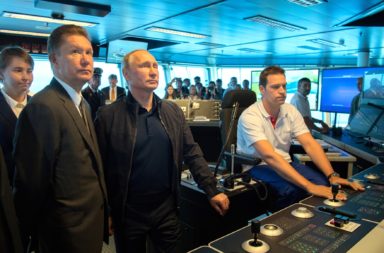One year ago Russian President Vladimir Putin signed a new document named “About the Strategy of National Security for the Russian Federation,” on January 1st, 2016.
It blames the United States and NATO for all problems, with Russia as the victim of the desire of the West for ‘global dominance’.
“The strengthening of Russia happens against the background of new threats to the national security, which has complex and interrelated nature.” The Kremlin argues: Conducting an independent policy has produced counteractions from the USA and its allies, which are striving to retain their dominance in global affairs.That lead to political, economical, military and informational pressure on Russia.
The Western alliance’s approach to Russia’s borders, is described as “a threat to Russia’s national security.”
“The buildup of the military potential of the North Atlantic Treaty Organization (NATO) and vesting it with global functions implemented in violations of norms of international law, boosting military activity of the bloc’s countries, further expansion of the alliance, the approach of its military infrastructure to Russian borders create a threat to the national security,” it says.
“Russia’s strengthening is taking part on the background of new threats to national security that have a complicated and interlinked character. The independent domestic and foreign policy conducted by Russia triggers counteraction from the U.S. and their allies seeking to keep up their domination in global affairs.”
Russia’s hostile view on the West in general, mainly the U.S. and NATO, is nonsense and at the same time as well dangerous for the national interests of the Russian Federation.
Why?
1. In the Baltic NATO members states NATO had until summer last year only four tanks, according to NATO general Lothar Domröse. What a tiny “threat” this is for Russia with many more Russian troops stationed at the NATO border in front of the Baltic states.
NATO says the Russians deployed 95,000 soldiers in offense-orientated scenarios along the border to the military alliance in 2015. A nuclear-rocket attack on Warsaw is said to have been simulated along with attacks against the three Baltic states, under the maneuver name Zapad (“West”). Russia spends 4.5 percent of its GDP for defense, most European states just less than 2 percent.
The wish of the Baltic and the Eastern European states to join NATO after the USSR collapsed in 1991 was not to attack Russia all together, but to be save from adventurists and nationalists in Moscow after Eastern Europe had been suppressed by a Russian dictatorship from 1945 to the 1990th. And the Baltic states eaten up with the Hitler-Stalin pact years earlier. See the Globalo clip of Estonian MEP Tunne Kelam here. So the other way around.
2. At the NATO Summit in Warsaw July 8/9th, 2016 the alliance decided to fill its defense credibility gap with several new structures:
The Readiness Action Plan (RAP) ensures the Alliance is ready to respond swiftly and firmly to new security challenges from the east and the south. Begun at the 2014 Wales Summit, this is the most significant reinforcement of NATO’s collective defence since the end of the Cold War. At Warsaw, Heads of State and Government welcomed its implementation and introduced new work on NATO’s deterrence and defence posture.
Due to the changed security environment on NATO’s borders, the RAP includes ‘assurance measures’ for NATO member countries in Central and Eastern Europe to reassure their populations, reinforce their defence and deter potential aggression.
Assurance measures comprise a series of land, sea and air activities in, on and around the NATO’s eastern flank, which are reinforced by exercises focused on collective defence and crisis management.
The RAP also includes ‘adaptation measures’ which are longer-term changes to NATO’s forces and command structure so that the Alliance will be better able to react swiftly and decisively to sudden crises.
Adaptation measures include tripling the strength of the NATO Response Force (NRF), creating a Very High Readiness Joint Task Force (VJTF) that is able to deploy at very short notice, and enhancing Standing Naval Forces.
To facilitate readiness and the rapid deployment of forces, the first six NATO Force Integration Units (NFIUs) – which are small headquarters – were established in Central and Eastern Europe. Two more NFIUs are being set up in Hungary and Slovakia. Headquarters for the Multinational Corps Northeast in Szczecin, Poland and the Multinational Division Southeast in Bucharest, Romania were also established. In addition, a standing joint logistics support group headquarters is being set up.
The NATO Response Force (NRF) is a highly ready and technologically advanced multinational force made up of land, air, maritime and Special Operations Forces (SOF) components that the Alliance can deploy quickly, wherever needed. At the 2014 Wales Summit, Allies decided to enhance the NRF to strengthen the Alliance’s collective defence and ensure that NATO has the right forces in the right place at the right time. The NRF now consists of about 40,000 personnel – a major increase from the previous level of 13,000.
The quick-reaction Very High Readiness Joint Task Force (VJTF) or “spearhead force” of around 20,000, of which about 5,000 are ground troops, is now operational and is able to begin deployment within two to three days wherever it is needed. The VJTF will be supported by air, maritime and SOF components.
First, six multinational NATO Force Integration Units (NFIUs) were established in Bulgaria, Estonia, Latvia, Lithuania, Poland and Romania and inaugurated in September 2015, constituting a visible and persistent NATO presence in these countries. Two more NFIUs are being set up in Hungary and Slovakia.These NFIUs are small headquarters that will facilitate the rapid deployment of the VJTF and Allied follow-on forces. They are being staffed by about 40 national and NATO specialists. Their task will be to improve cooperation and coordination between NATO and national forces, as well as to prepare and support exercises and any deployments needed.
The Multinational Corps Northeast Headquarters developed by Denmark, Germany and Poland is now fully operational. It provides an additional high-readiness capability to command forces deployed to the Baltic States and Poland, if required, and to enhance its role as a hub for regional cooperation. A new deployable multinational divisional headquarters for the southeast was inaugurated in Bucharest on 1 December 2015.
3. NATO has neither political intensions, nor plans or enough equipment to attack and conquer large Russia. This is well known in the military and intelligence services of the Russian Federation.
4.. The problems started with the involvement of Russian troops “on vacation with weapons” in Eastern Ukraine in violation of all international laws. Not NATO invaded in Europe a foreign country, but Russia.
5. According to international law each country has the free right to join any defense alliances. Why isn’t Russia inviting all Eastern European states to join its own alliance and wait what the answers will be?
6. Russia needs be be strong inside, otherwise becomes an empty shell. It has to invest in education, research, small businesses, or infrastructure, less in weapons. But as in the USSR the Kremlin again expands more and more money in armament programs.This was the main mistake of the communists, to invest to fight a threat-phantom with too much money burned.
7. The real threats for Russia come not from NATO nor the U.S., but three very effective ticking political atomic-bombs:
First, the 8times bigger and much stronger and lively Chinese XXL dragon in the soft belly of empty Siberia. Rich Chinese buy land there, infiltrate economy and local politics with corruption. The new giant Silk Road and railway project of Beijing is integrating the Central Asian states only south of Russia. China buys Russian gas, but under its own conditions. Beijing sets the rules.
Second, the loss of the 1500 years old Christian identity, when the majority of Russian will be Muslims in maybe 30-50 years from now. With maybe one to five percent frustrated radicals, many now fighting in Syria with ISIS (Daesh).
Third, too little innovation and small businesses in Russia burdened with too much administration and corruption, making Russia weak inside.
Unfortunately Russia is about to make a severe misperception of her own interests in 2017.
Russia is too weak to be an equal partner with China. China prefers good relations with Western Europe and several Asian states.
Moscow needs the West, the EU and NATO to be strong in the future.
If you invade and threaten your neighbors, you lose much more than you can win.
Until now the adventure in Ukraine has cost Mother Russia more than $ 300 billion- an expensive adventure. Thus it makes Russia weaker, not stronger.
Moscow needs Western technology, now blocked by sanctions.
The Kremlin still thinks in the black-and-white of the Cold War, from way back when Putin was a young spy.
They forget, that power needs a strong economy today.
This is only possible with international cooperation and many creative young people and entrepreneurs who need the oxygen of freedom in order to be successful.
An ossified Russia is indeed the way to make the country weaker and weaker each day.
The country is in danger to be eaten up by a Chinese Dragon from outside or a radical Islam in 2050 from within. Slowly, step by step, until it is to late.
A stiff, paralyzed state.
This hard-rock-narrow-minded-no-reform-style was the end of the USSR in the 1990th – is it now to be repeated under a smart leader like Mr Putin? The beginning of the end game?
A re-set of NATO-Russian relations should be initiated by Brussels, the European states and new US president Donald Trump , including open discussions about common security interests.
Putin should design a real progressive Grand Strategy, not brew up an old tea-bag from the Cold War.




